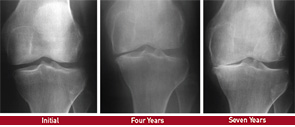Biolubricants
The high viscosity of synovial fluid and boundary lubricants on the articular surface maintain healthy cartilage as a near frictionless biomaterial.17 One of the most important boundary lubricants is a protein by the name of lubricin, encoded by the Proteoglycan 4 (PRG4) gene.7
Lubricin is a large glycoprotein present in synovial fluid and within the most superficial zones of cartilage surfaces. Synovial lining cells and superficial chondrocytes make this molecule. The importance of lubricin is highlighted by the phenotype of patients with mutations in PRG4, who develop precocious OA and often require early joint replacement.7 Likewise, mice with Prg4 mutations are born with normal appearing joints that also undergo an OA-like process.18
Beyond these extreme genetic examples, the behavior of lubricin in the context of established OA is less clear. Some studies suggest that acute insults, such as ligament tears, reduce lubricin levels, and others have found either elevated or decreased amounts of this glycoprotein in OA joints.7 Regardless, joint lubrication is likely to be decreased on the whole in traumatic and OA joints, and this may perpetuate degeneration.
To mitigate reduced joint lubrication in OA, a number of groups have supplemented the joints of animals with excess lubricin. In rats, intra-articular lubricin attenuated post-traumatic OA after meniscal or ligamentous injury.19-22 Due to the short half-life of lubricin, however, frequent joint injections were required. To circumvent this issue, which would limit any clinical application, Ruan et al developed a non-infectious adenovirus that could deliver the Prg4 gene to synoviocytes and chondrocytes after a single injection, resulting in long-term expression (i.e., months).23 When mice overexpressing lubricin underwent ACL transection, they were protected from OA. Each of these studies used excess lubricin in a prophylactic approach. Whether increasing lubricin in established OA has a therapeutic benefit in animal models remains to be determined.

Stem Cell Therapies
Therapies with the potential to regenerate healthy cartilage are perhaps the most intellectually attractive in the context of OA. Indeed, patients often ask, “Is there anything you can inject that will regrow the cartilage in my knee?”
Cell-based therapies for the treatment of cartilage defects have been used for the better part of two decades.24 Typically, this procedure involves an initial cartilage harvest via arthroscopy from which chondrocytes are isolated and expanded. These expanded chondrocytes are then injected into the cartilage defect(s) during a second surgery, either embedded within a scaffold or under a membrane.